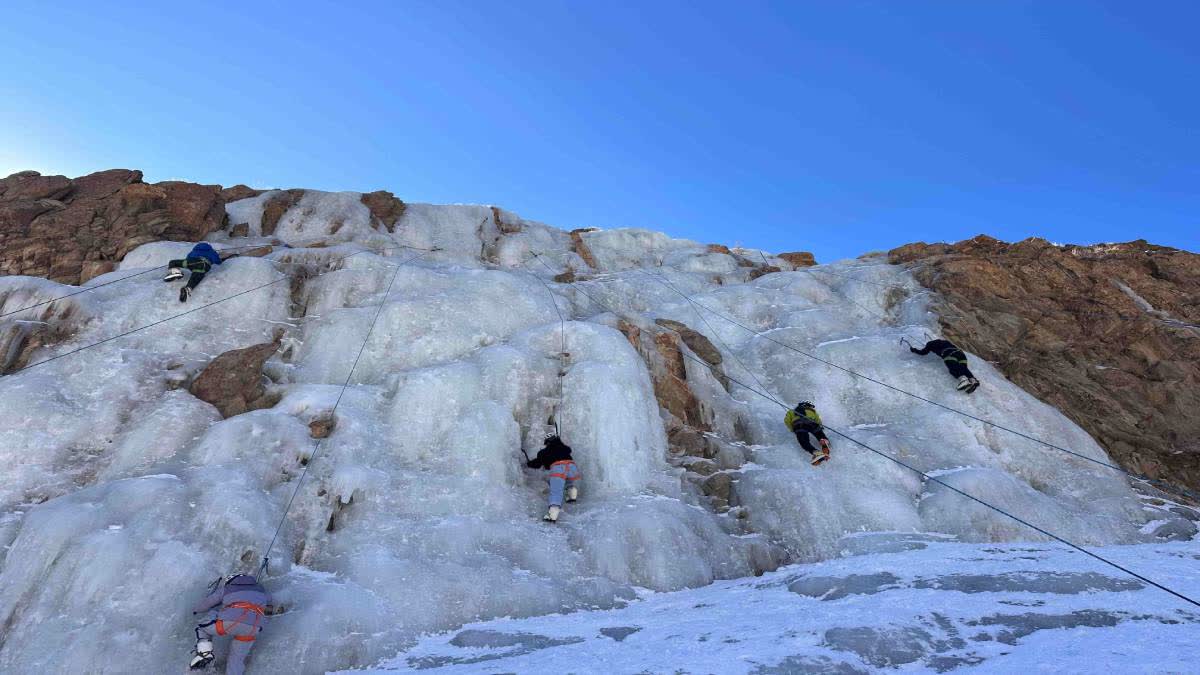Leh: The sharp clang of ice axes hitting the frozen wall reverberated through the Gangles Ice Wall as young climbers inched their way to the top. For 11-year-old Stanzin Wangtak from Yougar village, it was the second year of participating in the Ladakh Ice Climbing Fest, and the thrill was as fresh as ever.
"Reaching the top feels amazing. The starting slope is easy, but the main ice wall is tough. But that's what makes it so exciting," he said in excitement.
This year marked the sixth successful edition of the Ladakh Ice Climbing Fest, organised by the Ladakh Mountain Guide Association (LMGA). What started as an initiative to keep the schoolchildren engaged during the long winter vacations, has now become a platform for young climbers to test their grit and determination. More than 60 students, some travelling from remote villages like Shara, stood in line, eager to challenge themselves against the towering ice wall.
Skalzang Rigzin, president of the Ladakh Mountain Guide Association, said, "During a trek to the Mushtaq Glacier with members of the Indian Air Force in 2013, we realised the need for professional mountaineering guides in Ladakh. This led to the formation of LMGA, which was officially registered in 2021.
"The festival aims to raise awareness among children about the crucial role of glaciers in our ecosystem—without them, there would be no water. Through this initiative, we also emphasise the importance of keeping the environment clean, as it ensures healthy and sustainable glaciers," Rigzin said.
"Beyond that, we wanted to engage the youth in sports as a positive outlet, keeping them away from negative influences. Ice climbing not only boosts their physical fitness but also increases their confidence and concentration. The sense of achievement after reaching the top of the ice wall brings them joy," he added.
"I am proud to say that two of our guides have received certificates from the International Federation of Mountain Guides Association (IFMGA), the international governing body for formulating standards. In future, we aim to build the ice wall as per the international standards so that we can compete with sportspersons all over the world," he said.
"It took us 15 days to form the ice due to leakages in the channel, which is nearly 30 years old. We had to divert water from 1.5 km away to create the artificial ice wall. In future, we have the potential to build a world-class ice wall, approximately 100-170 meters high and 50-60 meters in length. This would not only enhance the festival but also attract more tourists to ice climbing. Since the first edition, we have welcomed around 2,000 to 3,000 participants," he said further.
At the closing ceremony, Dr Pawan Kotwal, the advisor of Ladakh, emphasised the need to develop Ladakh as a winter sports destination and applauded the organisation for conducting such an event for the children. "For the children, the Ice Climbing Fest is a great learning experience and a good exposure. The administration will provide future support in developing the canals so that the ice wall can be made according to international standards. I wish all young kids become ace mountain climbers in the future," Kotwal said.
Tsering Angchuk, deputy chairman of Ladakh Autonomous Hill Development Council (LAHDC), Leh, said, "I attended the first Ice Climbing Fest and it is great to see this initiative has become more and more successful each year. The young children here are very lucky to experience this at their doorstep and I urge them to take the utmost advantage of this opportunity."
"This initiative not only provides a source of income but also opens doors for international exposure, allowing us to meet and interact with people from different parts of the world. Beyond government jobs, ice climbing and mountaineering can be pursued as a full-fledged career, requiring internationally recognised skills and qualifications. Our primary work revolves around mountain expeditions, including peaks like Nun Kun, East Karakoram and Kang Yatse in the Markha Valley. The expedition season typically runs from June to October, with July, August and September being the peak months," he added.
"Earlier, August used to be much colder, but now the temperatures are noticeably warmer. Winter snow no longer lasts as long as it used to, and as a result, rocks that were once held firmly by snow are now exposed, increasing the chances of rockfall. This shift indicates a significant change in weather patterns. The Indian Mountaineering Foundation (IMF) issues permits for expeditions to peaks above 6,000 and 7,000 meters, with a limit of 12 members per expedition. However, the UT Administration has recently drafted a new policy that allows for around 100 permits annually for select peaks, which is a positive step towards promoting mountaineering in the region," Rigzin said.
Avinash Bhardwaj, a participant, shared his one-of-a-kind experience."This is a very well-organised event with professional guides. I am participating for the first time in this sport and my friends are looking forward to participating in it next year. I wish this was happening for a longer time," he said.
Also Read:



